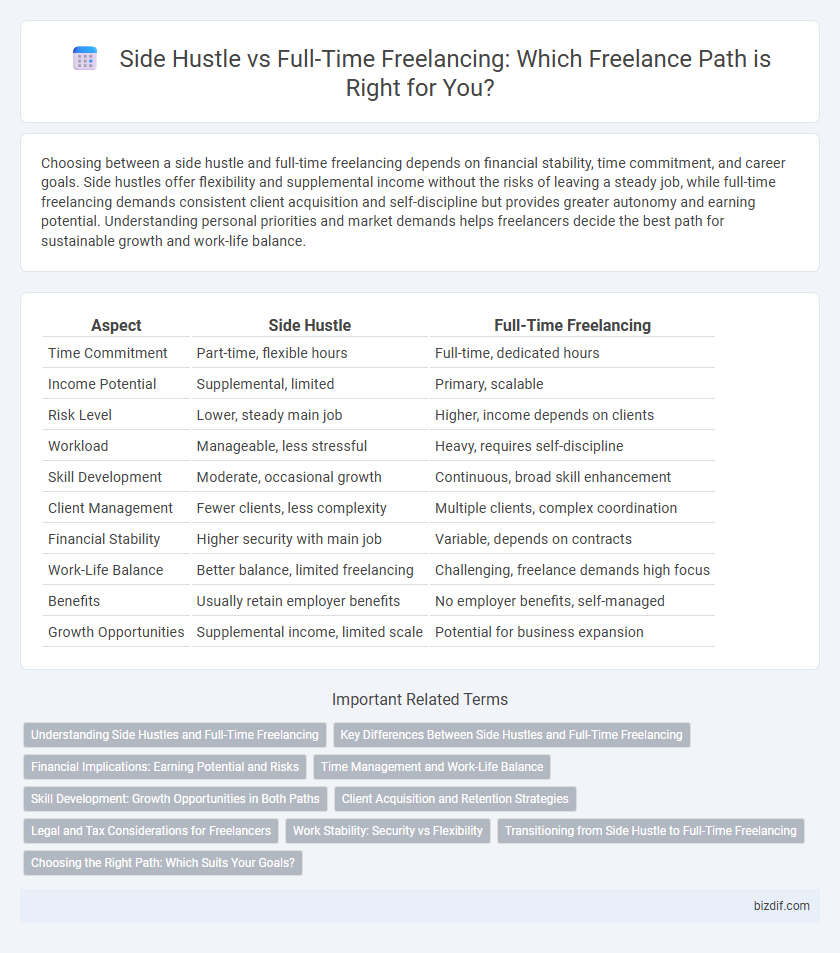Choosing between a side hustle and full-time freelancing depends on financial stability, time commitment, and career goals. Side hustles offer flexibility and supplemental income without the risks of leaving a steady job, while full-time freelancing demands consistent client acquisition and self-discipline but provides greater autonomy and earning potential. Understanding personal priorities and market demands helps freelancers decide the best path for sustainable growth and work-life balance.
Table of Comparison
| Aspect | Side Hustle | Full-Time Freelancing |
|---|---|---|
| Time Commitment | Part-time, flexible hours | Full-time, dedicated hours |
| Income Potential | Supplemental, limited | Primary, scalable |
| Risk Level | Lower, steady main job | Higher, income depends on clients |
| Workload | Manageable, less stressful | Heavy, requires self-discipline |
| Skill Development | Moderate, occasional growth | Continuous, broad skill enhancement |
| Client Management | Fewer clients, less complexity | Multiple clients, complex coordination |
| Financial Stability | Higher security with main job | Variable, depends on contracts |
| Work-Life Balance | Better balance, limited freelancing | Challenging, freelance demands high focus |
| Benefits | Usually retain employer benefits | No employer benefits, self-managed |
| Growth Opportunities | Supplemental income, limited scale | Potential for business expansion |
Understanding Side Hustles and Full-Time Freelancing
Side hustles provide flexible income streams by allowing individuals to earn money alongside their primary job, often requiring less time commitment and lower risk. Full-time freelancing demands a consistent workload, self-discipline, and business management skills to sustain long-term financial stability and career growth. Understanding the differences in income stability, client acquisition, and work-life balance is crucial for choosing between side hustling and full-time freelancing.
Key Differences Between Side Hustles and Full-Time Freelancing
Side hustles typically involve part-time freelancing alongside a primary job, offering supplemental income without the pressure of full financial dependence, while full-time freelancing requires managing client acquisition, project deadlines, and business expenses independently. Full-time freelancers must develop advanced skills in self-marketing, time management, and financial planning, contrasting with the more flexible and low-risk commitment of side hustles. Income stability varies significantly as side hustles provide supplementary earnings, whereas full-time freelancing demands consistent client flow to sustain a livelihood.
Financial Implications: Earning Potential and Risks
Side hustles in freelancing provide supplemental income with lower financial risk but typically offer limited earning potential compared to full-time freelancing, which demands consistent client acquisition and income variability. Full-time freelancing can generate significantly higher revenue streams but involves variable cash flow, lack of employee benefits, and greater financial uncertainties such as inconsistent project flow and delayed payments. Managing budgeting, taxes, and emergency funds is crucial for both models to mitigate risks and ensure financial stability.
Time Management and Work-Life Balance
Balancing a side hustle with a full-time job requires strategic time management, often limiting freelance work to evenings and weekends, which can strain personal time and reduce work-life harmony. Full-time freelancing offers greater schedule flexibility, enabling freelancers to allocate work hours around personal priorities, but it demands disciplined time management to avoid burnout. Effective work-life balance in both scenarios hinges on setting clear boundaries and prioritizing tasks to maximize productivity without sacrificing personal well-being.
Skill Development: Growth Opportunities in Both Paths
Side hustles offer flexible skill development opportunities, allowing freelancers to experiment with diverse projects and gradually build expertise without the pressure of immediate income dependence. Full-time freelancing accelerates growth by demanding consistent client engagement, advanced project management skills, and deeper specialization in niches, fostering rapid professional maturity. Both paths provide valuable experiences that contribute to continuous learning and adaptability in the evolving freelance marketplace.
Client Acquisition and Retention Strategies
Side hustles in freelancing often rely on leveraging personal networks and social media platforms for initial client acquisition, while full-time freelancers prioritize building a professional portfolio and investing in targeted marketing campaigns to attract diverse clientele. Effective client retention strategies include consistent communication, delivering high-quality work on time, and offering personalized services tailored to client needs. Utilizing CRM tools and seeking regular feedback significantly enhances relationship management and fosters long-term collaboration.
Legal and Tax Considerations for Freelancers
Freelancers operating as a side hustle must comply with tax regulations such as self-employment tax and may need to file estimated quarterly taxes to avoid penalties. Full-time freelancers face more complex legal considerations, including registering a business entity like an LLC for liability protection and managing payroll taxes if hiring subcontractors. Both should maintain detailed records of income and expenses to ensure accurate tax reporting and benefit from potential deductions.
Work Stability: Security vs Flexibility
Side hustles offer greater work flexibility, allowing freelancers to balance multiple income streams without full dependence on freelance projects. Full-time freelancing provides work stability through consistent client relationships and focused project commitments, though it may entail higher income volatility. Choosing between side hustle and full-time freelancing depends on the individual's need for financial security versus the desire for adaptable schedules.
Transitioning from Side Hustle to Full-Time Freelancing
Transitioning from a side hustle to full-time freelancing requires careful financial planning and building a consistent client base to ensure steady income. Developing a specialized skill set and establishing a strong online presence on platforms like Upwork or Fiverr can accelerate growth and credibility in the freelancing market. Prioritizing time management and setting clear business goals help maintain productivity and long-term sustainability during this career shift.
Choosing the Right Path: Which Suits Your Goals?
Choosing between side hustle and full-time freelancing depends on your financial stability, risk tolerance, and long-term career objectives. Side hustling offers supplemental income while maintaining job security, ideal for those testing freelance viability or building a client base. Full-time freelancing demands consistent client acquisition and self-discipline but provides greater income potential, flexibility, and control aligned with entrepreneurial goals.
Side Hustle vs Full-Time Freelancing Infographic

 bizdif.com
bizdif.com